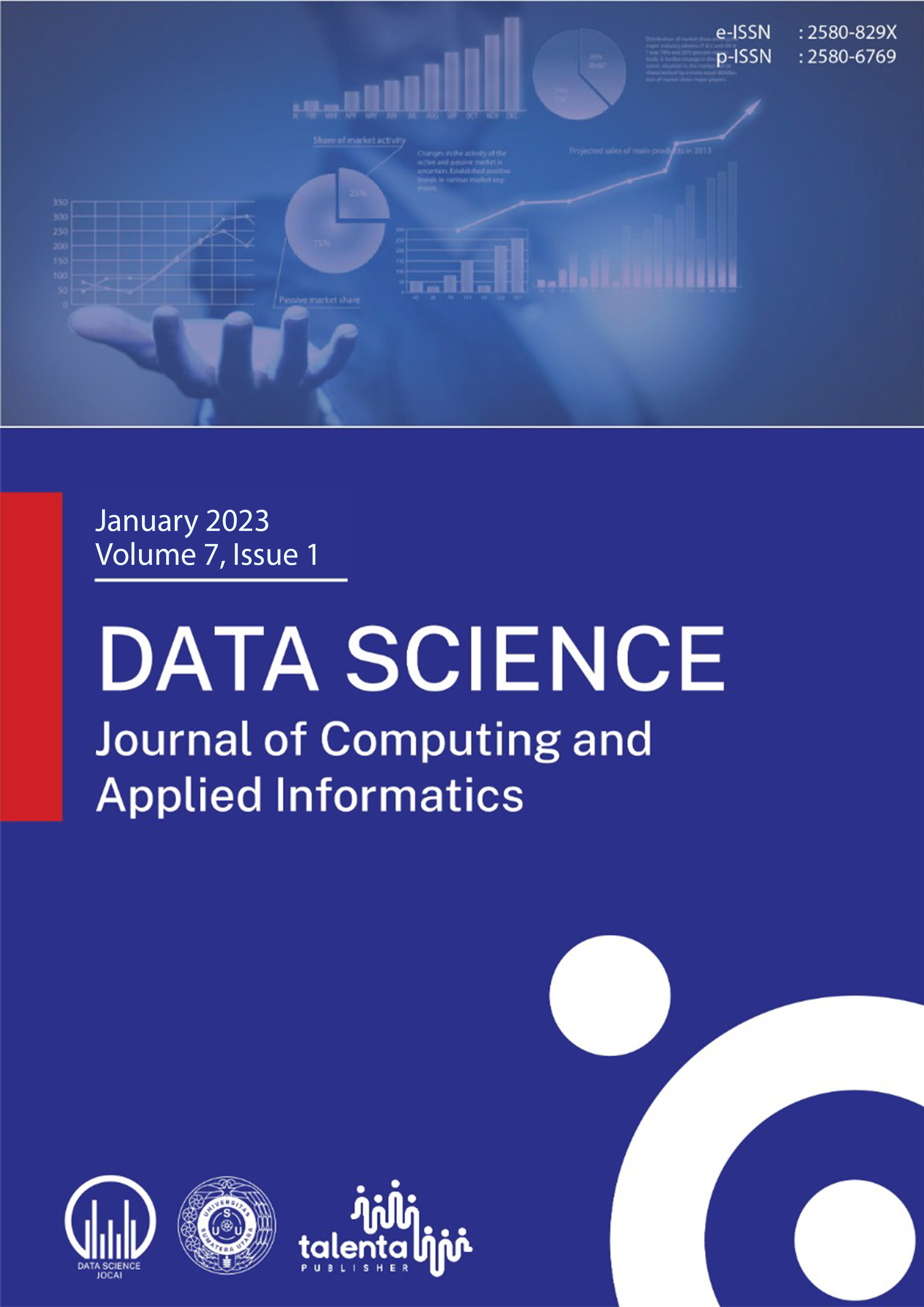Analysis of Embedding Locations in the Subband Frequency DCT on Scanned Images
DOI:
https://doi.org/10.32734/jocai.v7.i1-10359Keywords:
Discrete Cosine Transform, Invisible Watermark, PSNR, SSIM, Subband DCT, Watermarking TechiqueAbstract
Uploading an identity card as an image for the account verification process or transactions online can be a threat to application users. Identity card theft can be carried out by irresponsible persons if the application can be hacked. Therefore, protection of the image is required for authentication. In this study, the proposed technique is watermarking. A watermark in the form of a binary image will be embedded into the image as ownership using a Discrete Cosine Transform. The Discrete Cosine Transform works in the frequency domain. The location of the embedding of different watermarks was analysed in each 8×8 DCT block. The results of the analysis to assess the imperceptibility of original images and watermarked images using PSNR (Peak Signal to Noise Ratio) and SSIM (Structural Similarity Index Measure), while assessing the watermark robustness embedded using NCC (Normalized Cross Correlation). The results show PSNR (Peak Signal to Noise Ratio) ≥ 54 dB with a watermark strength of 0,1 and an average SSIM (Structural Similarity Index Measure) ≥ 0,9 on 4 scanned images in BMP format with a resolution of 100 DPI. A good watermark embedding is done on the green component at middle frequencies to maintain a balance between imperceptibility and robustness. In contrast, the red component at low frequency is vulnerable to attacks in the form of brightness +20 and contrast +50 with an average NCC (Normalized Cross Correlation) ≤ 0,85.
Downloads
References
C.-C. Chang, T.-C. Lu, Z.-H. Zhu, and H. Tian, “An Effective Authentication Scheme Using DCT for Mobile Devices,†Symmetry (Basel)., vol. 10, no. 1, p. 13, 2018, doi: 10.3390/sym10010013.
N. Hasan, M. S. Islam, W. Chen, M. A. Kabir, and S. Al-Ahmadi, “Encryption Based Image Watermarking Algorithm in 2DWT-DCT Domains,†Sensors, vol. 21, no. 16, p. 5540, 2021, doi: 10.3390/s21165540.
K. Jagdale, K. Pujari, M. Dudhanikar, and D. Gaikwad, “Digital Image Watermarking by Using Discrete Cosine Transform Methodology,†Int. J. Futur. Gener. Commun. Netw., vol. 13, no. 2s, pp. 521–526, 2020.
R. A. Asmara, R. Agustina, and Hidayatulloh, “Comparison of Discrete Cosine Transforms (DCT), Discrete Fourier Transforms (DFT), and Discrete Wavelet Transforms (DWT) in Digital Image Watermarking,†Int. J. Adv. Comput. Sci. Appl., vol. 8, no. 2, pp. 245–249, 2017, doi: 10.14569/IJACSA.2017.080232.
R. Thanki, S. Borra, V. Dwivedi, and K. Borisagar, “An efficient medical image watermarking scheme based on FDCuT–DCT,†Eng. Sci. Technol. an Int. J., vol. 20, no. 4, pp. 1366–1379, 2017, doi: 10.1016/j.jestch.2017.06.001.
D. E. Kurniawan, N. R. Hartadi, and P. Prasetyawan, “Analisis Hasil Teknik Penyembunyian Hak Cipta Menggunakan Transformasi DCT dan RSPPMC pada Jejaring Sosial,†J. Teknol. Inf. dan Ilmu Komput., vol. 5, no. 3, pp. 261–268, 2018, doi: 10.25126/jtiik.201853692.
L. Rakhmawati, S. Suwadi, and W. Wirawan, “Blind Robust and Self-Embedding Fragile Image Watermarking for Image Authentication and Copyright Protection with Recovery Capability,†Int. J. Intell. Eng. Syst., vol. 13, no. 5, pp. 197–210, 2020, doi: 10.22266/ijies2020.1031.18.
E. H. Rachmawanto, D. R. I. M. Setiadi, C. A. Sari, and N. Rijati, “Imperceptible and secure image watermarking using DCT and random spread technique,†TELKOMNIKA, vol. 17, no. 4, pp. 1750–1757, 2019, doi: 10.12928/TELKOMNIKA.v17i4.9227.
R. Krasmala, A. B. Purba, and U. T. Lenggana, “Kompresi Citra Dengan Menggabungkan Metode Discrete Cosine Transform ( DCT ) dan Algoritma Huffman,†JOIN, vol. 2, no. 1, pp. 1–9, 2017.
Z. Yuan, Q. Su, D. Liu, X. Zhang, and T. Yao, “Fast and robust image watermarking method in the spatial domain,†IET Image Process., vol. 14, no. 5, pp. 3829–3838, 2020, doi: 10.1049/iet-ipr.2019.1740.
S. E. Tsai and S. M. Yang, “A Fast DCT Algorithm for Watermarking in Digital Signal Processor,†Math. Probl. Eng., vol. 2017, no. Article ID 7401845, p. 7, 2017, doi: 10.1155/2017/7401845.
M. Hamidi, M. El Haziti, H. Cherifi, and M. El Hassouni, “A Hybrid Robust Image Watermarking Method Based on DWT-DCT and SIFT for Copyright Protection,†J. Imaging, vol. 7, no. 10, p. 218, 2021, doi: 10.3390/jimaging7100218.
P. Bogacki and A. Dziech, “Analysis of New Orthogonal Transforms for Digital Watermarking,†Sensors, vol. 22, no. 7, p. 2628, 2022, doi: 10.3390/s22072628.
D. Ariatmanto and F. Ernawan, “Adaptive scaling factors based on the impact of selected DCT coefficients for image watermarking,†J. King Saud Univ. - Comput. Inf. Sci., vol. 34, no. 3, pp. 605–614, 2022, doi: 10.1016/j.jksuci.2020.02.005.
G. Melendez-Melendez and R. Cumplido, “Reversible image authentication scheme with blind content reconstruction based on compressed sensing,†Eng. Sci. Technol. an Int. J., vol. 34, p. 101080, 2022, doi: 10.1016/j.jestch.2021.101080.
N. A. Loan, N. N. Hurrah, S. A. Parah, J. W. Lee, J. A. Sheikh, and G. M. Bhat, “Secure and Robust Digital Image Watermarking Using Coefficient Differencing and Chaotic Encryption,†IEEE Access, vol. 6, pp. 19876–19897, 2018, doi: 10.1109/ACCESS.2018.2808172.
L. Novamizanti, I. Wahidah, and N. P. D. P. Wardana, “A Robust Medical Images Watermarking Using FDCuT-DCT-SVD,†Int. J. Intell. Eng. Syst., vol. 13, no. 6, pp. 266–278, 2020, doi: 10.22266/ijies2020.1231.24.
S.-W. Byun, H.-S. Son, and S.-P. Lee, “Fast and Robust Watermarking Method Based on DCT Specific Location,†IEEE Access, vol. 7, pp. 100706–100718, 2019, doi: 10.1109/ACCESS.2019.2931039.
P. N. Andono, T. Sutojo, and Muljono, Pengolahan Citra Digital, 1st ed. Yogyakarta: ANDI, 2017.
J. L. D. Shivani and R. K. Senapati, “Robust Image Embedded Watermarking Using DCT and Listless SPIHT,†Futur. Internet, vol. 9, no. 3, p. 33, 2017, doi: 10.3390/fi9030033.
M. Begum and M. S. Uddin, “Digital Image Watermarking Techniques : A Review,†Information, vol. 11, no. 2, p. 110, 2020, doi: 10.3390/info11020110.
F. Ernawan, D. Ariatmanto, and A. Firdaus, “An Improved Image Watermarking by Modifying Selected DWT-DCT Coefficients,†IEEE Access, vol. 9, pp. 45474–45485, 2021, doi: 10.1109/ACCESS.2021.3067245.
M. Ali, C. W. Ahn, M. Pant, S. Kumar, M. K. Singh, and D. Saini, “An Optimized Digital Watermarking Scheme Based on Invariant DC Coe ffi cients in Spatial Domain,†Electronics, vol. 9, no. 9, p. 1428, 2020, doi: 10.3390/electronics9091428.
Downloads
Published
How to Cite
Issue
Section
License
Copyright (c) 2023 Data Science: Journal of Computing and Applied Informatics

This work is licensed under a Creative Commons Attribution-ShareAlike 4.0 International License.















